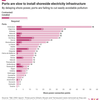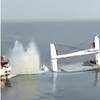The recent oil price fluctuations may have wreaked havoc with many offshore service companies; but Seacor Smit managed to pull through, relatively unscathed.
With a strong balance sheet and a modernized fleet, Seacor Smit, a leading offshore service and supply company, managed to ride out the recent oil price fluctuation with minimal damages.
Charles Fabrikant, chairman, president and CEO, points to the company's adherence to a policy of acquiring modern vessels, while pruning those less marketable, or more expensive to operate. The core of the program is replacing vessels serving primary markets - like deepwater - and shifting older assets to less demanding services.
In the course of a year, Seacor disposed of 34 vessels, generating $144 million in cash. Of the 34, 23 were sold outright to third parties, and 11 were sold to leasing companies and chartered back to Seacor. This pruning of the fleet resulted in a reduction in the average age of company-owned vessels, from 14.1 years of age to 13.6 years.
Fabrikant states he is not averse to older equipment, but rather, recognizes certain roles are more suited for newer vessels.
"Boats, like people, have a life cycle," he says. "Young boat perform certain jobs; older boats are quite adequate for others."
Specifically, Fabrikant points to standby services in the North Sea, where some vessels were commissioned more than 35 years ago. Utility boats are another class where "senior citizen" status is not an encumbrance.
In bad markets, Fabrikant says, owners usually opt to operate equipment, even when earning slim margins, providing they are covering variable costs. At some point, however, they need to face the decision of whether it pays to incur the cost to put a vessel through mandated surveys, due every five years.
After a vessel has been in service 20 years, the cost of maintenance typically escalates rapidly. Moreover, according to Fabrikant, given market prospects for the next 12 months, most vessels in service 20 years do not warrant the cash investment required for maintaining certification.
Seacor Smit does not put any vessel through survey, regardless of age, unless the company can recoup the cash laid out in three or four months.
Says Fabrikant, "I see no point in returning equipment to service in a market that cannot provide full employment for the part of our fleet that is already certified."
Fabrikant looks forward to an increase in drilling activity in the Gulf of Mexico. While he acknowledges profits and cash flow will inevitably decline in 1999 from 1998 ("Spot rates in all markets, for all vessels, are well below those prevailing last year," he says. "Since rates follow demand, utilization is also down."), the signs point to an upturn in drilling activity in North America.
Output from currently producing natural gas wells in the Gulf appears to be declining rapidly, he says. If oil drilling were to stop, there would be a reduction in supply available for delivery 12-18 months from now. It should be just a matter of time before commodity markets anticipate and price natural gas for future delivery accordingly.
However, he points out, even with increased activity, the marine support sector will probably not enjoy significant increases in day rates; certainly not approaching the rates and utilization levels experienced in 1997 and early 1998. Existing capacity of most classes of vessels is ample to service all available rigs in the Gulf.
As far as the recent consolidation of the oil majors, Fabrikant sees the short-term result being less spending on oilfield service and supply.
"There's strong evidence there's been less spending than would be the case, even in today's environment, had these mergers not taken place," he says. "However, I don't think this is a result of the mergers, necessarily, but rather, the process of putting together mega-mergers is a difficult task. Getting everyone organized is a higher priority than spending money."
In the long run, Fabrikant says, one would assume by creating stronger companies with higher efficiencies, there may actually be more money to spend on the exploration process. Even prospects deemed insignificant to an oil major, will probably be prospects to a smaller company. Overall, he says, he'd be surprised if the difference in spending is enormous, over time.
The changing patterns of the industry, particularly in the Gulf, have resulted in a wide array of vessels being offered. Previously, most supply vessels conformed to a standard design, with only minor differences, if any.
Today, however, supply vessels range in size, horsepower, cargo capacity and station-keeping.
Fabrikant says Seacor has been compiling data to determine the best mix of vessels. For example, increased payload is more productive when carrying cargo over long distances, he says; however, small boats can load at more berths and ports than larger vessels.
"When two small vessels can be had for the price of one large vessel, the larger, more sophisticated unit has to offer more than greater cargo capacity," he says. "Two units have more flexibility than one. Yes, the ability to work in adverse weather conditions has to be weighed against flexibility. Large vessels tend to provide a more stable platform. Still, it remains to be seen if 'bigger is better'."
Fabrikant says the company ordered two large platform supply vessels in 1997, based on the belief a company the size of Seacor should have some experimentation in the mix. The first vessel is scheduled for delivery this year; however, due to market conditions, and the possibility bigger boats might not be the best solution, the second vessel order was canceled.
Finally, yet another reason for Seacor's ability to weather the fluctuating oil price storm, was the strength of the company's balance sheet. Currently, liquid assets are roughly equal to debt.
"Thus, Seacor's cost of capital for the next seven to ten years is favorable. The company is in an enviable position," Fabrikant says. "The fleet is ready for the future, and the company can move forward with further fleet renewal at its own pace."
Sponsored Content
Safer Starts Here: Build Ships, Protect Crews

Subscribe for
Maritime Reporter E-News
Maritime Reporter E-News is the maritime industry's largest circulation and most authoritative ENews Service, delivered to your Email five times per week










